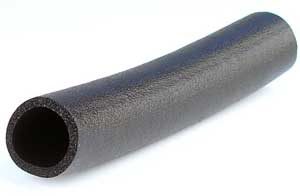AC Insulators
 Automotive Air Conditioning systems require the use of extensive lengths of aluminum tubing to carry refrigerant to various locations within the vehicle. How it works:
Automotive Air Conditioning systems require the use of extensive lengths of aluminum tubing to carry refrigerant to various locations within the vehicle. How it works:
Your AC system does not blow cold air on you. Instead, it takes the hot air in your vehicle and blows it across a super cooled set of tubes containing refrigerant: a heat exchanger. The refrigerant in the tubes absorbs the heat from the air coming from the car, turning it cold, then returns that air back into the vehicle as the cold air you actually feel. The refrigerant, now hot, must be pumped back to the central cooling unit where the heat is removed and the refrigerant is re-cooled, so it can be pumped back to the heat exchanger where the process can reoccur.
AC insulator tubing to create efficient AC cooling system
All of this requires a tremendous amount of tubing which must be insulated if the system ever hopes to be efficient. EPDM sponge material has been adapted to be especially useful in this application owing to its superior elasticity. The material stretches well over tube fitting without ripping or tearing and is very easy to handle (low tendency toward worker carpal tunnel disorder). Also, EPDM does exhibit good insulating characteristics and can be processed to an acceptably low density.
In home and commercial building air conditioning systems, PVC Nitrile is normally the material of choice owing to its high insulation properties and low density: very high number of feet of tubing insulation per pound of material used.
To offset the volatility (cost) of PVC nitrile compounds, Mantaline is engaged in developing a super low density EPDM that may effectively compete in the commercial marketplace.
Applies to AC insulators designed by Mantaline
Markets
Automotive Tier 1
Heavy Truck OEM
Materials
EPDM
Neoprene
Processes
Extrusion/Dense Foam
Cutting/Taping



